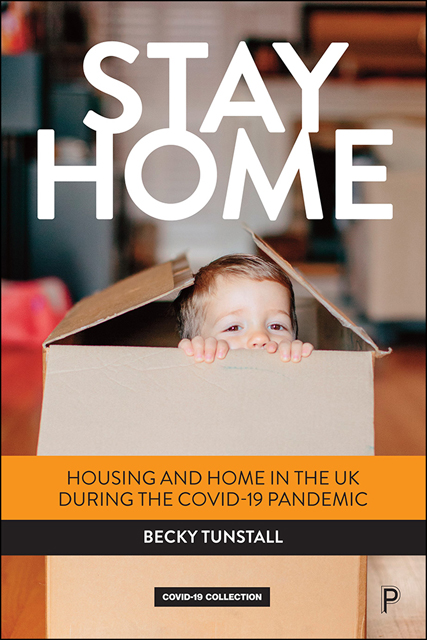Book contents
- Frontmatter
- Contents
- List of figures, tables and photos
- Acknowledgements
- 1 COVID-19, housing and home
- 2 UK households and homes before the pandemic
- 3 The pandemic and pandemic policy in the UK
- 4 People, households and time at home in the pandemic
- 5 The role of household and home in COVID-19 infection and death
- 6 Being vulnerable or ill at home in the pandemic
- 7 The impact of COVID-19 and COVID-19 policy on incomes, housing costs and housing security
- 8 The impact of COVID-19 and COVID-19 policy on the housing market
- 9 Summary and conclusions
- Appendix: The data from people aged 19, 31, 50, 62 and 74
- Notes
- References
- Index
3 - The pandemic and pandemic policy in the UK
Published online by Cambridge University Press: 20 June 2023
- Frontmatter
- Contents
- List of figures, tables and photos
- Acknowledgements
- 1 COVID-19, housing and home
- 2 UK households and homes before the pandemic
- 3 The pandemic and pandemic policy in the UK
- 4 People, households and time at home in the pandemic
- 5 The role of household and home in COVID-19 infection and death
- 6 Being vulnerable or ill at home in the pandemic
- 7 The impact of COVID-19 and COVID-19 policy on incomes, housing costs and housing security
- 8 The impact of COVID-19 and COVID-19 policy on the housing market
- 9 Summary and conclusions
- Appendix: The data from people aged 19, 31, 50, 62 and 74
- Notes
- References
- Index
Summary
The pandemic in the UK
Introduction
In the UK, the COVID-19 pandemic had three waves of infections and deaths between January 2020 and the start of 2022. ‘Age-standardised’ death rates were among the highest in Europe, although relatively lower in the second and third waves. Many sources have described the UK pandemic in detail, and discussed whether deaths, illness, hardship and expense could have been prevented. This chapter focuses on the developments key to understanding the links between the pandemic and housing and home.
The beginning
In hindsight, the earliest known test-confirmed case and death from COVID-19 in the UK was that of Peter Attwood of Chatham, who died on 30 January 2020 aged 84. The fact that he had COVID-19 was only discovered from later testing of a sample and was reported on 5 March. His daughter believed he caught the infection from her, because she had COVID-like symptoms on 15 December 2019. This would make her the first likely case in the UK and her father possibly the first case of household transmission in the UK.
The first UK lab-confirmed cases of COVID-19 recognised at the time were two people in York tested on 30 January 2020, who had travelled from China and had minimal symptoms. On 6 February 2020, a man tested positive in Brighton, again with minimal symptoms. He had caught the infection in Singapore, and infected people in France and the UK. Within days, the SPI-M subcommittee of SAGE thought there was already sustained transmission in the UK, which was later confirmed. A UK citizen on the Diamond Princess cruise ship died on 28 February after testing positive, and the first known death in the UK was on 5 March. There may have been many cases and some deaths before these ‘firsts’, which went undetected at the time. On 13 March 2020, researchers said that ‘by the time a single Covid death is reported, hundreds or thousands of cases are likely to be present [in a country]’.
On 3 February 2020, there were eight confirmed cases, and on 5 March, there were more than 100.
- Type
- Chapter
- Information
- Stay HomeHousing and Home in the UK during the COVID-19 Pandemic, pp. 32 - 54Publisher: Bristol University PressPrint publication year: 2022



